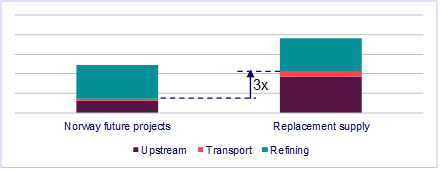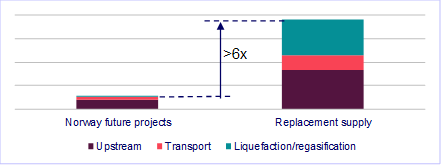Get in touch
-
Mark Thomtonmark.thomton@woodmac.com
+1 630 881 6885 -
Hla Myat Monhla.myatmon@woodmac.com
+65 8533 8860 -
Chris Bobachris.boba@woodmac.com
+44 7408 841129 -
Angélica Juárezangelica.juarez@woodmac.com
+5256 4171 1980 -
BIG PartnershipWoodMac@BigPartnership.co.uk
UK-based PR agency
Replacing Norway’s oil and gas supplies to Europe with imports would significantly increase emissions between 2024-2040
Wood Mackenzie report states that oil imports into Europe have 300% greater carbon emissions
2 minute read
Replacing oil and gas production from future Norwegian developments with like-for-like imported volumes from other parts of the world would result in an emissions increase of 230 million tonnes of carbon dioxide equivalent (tCO2e) between 2024T and 2040 according to a report published by Wood Mackenzie.
The report: ‘Norway Emissions Assessment’ was produced for Norwegian oil and gas producer Aker BP who commissioned Wood Mackenzie† to conduct an independent analysis of the impact of reducing oil and gas production in Norway. This followed recent court rulings in Norway invalidating permits for three offshore oil and gas developments for not considering the impact of the future use of produced hydrocarbons on the global climate.
Value chain emissions for oil

Source: Wood Mackenzie Consulting
The report found that as Europe’s largest hydrocarbons producer with combined production of 4 million barrels of oil equivalent per day (boed) Norway sends more than 90% of its exports to the European market. Despite this, Europe is a net importer of oil and gas with regional production only accounting for 25% and 45% of demand respectively
Value chain emissions for gas

Source: Wood Mackenzie Consulting
“Oil and gas demand is declining in Europe; however, it is forecast to account for over 50% of the primary energy mix in 2040 and will still play a critical role during the energy transition,” says report lead author Malcolm Forbes-Cable, Vice President of Consulting at Wood Mackenzie. “This means that Norway’s oil and gas, which has the world’s lowest average carbon emissions intensity, also has a critical role to play.”
Forbes-Cable adds that the low carbon emissions intensity of Norway’s oil and gas production is due to the country’s high operating standards and includes the widespread electrification of operations from hydropower and strict methane management. The proximity to the European market also makes a difference with other suppliers having to factor in emissions created by greater transportation distances.
The report also states that its findings discovered that oil imported into Europe has three times more carbon intensity than its Norwegian counterpart while gas had six times more.
Editor’s notes
- †Aker BP commissioned Wood Mackenzie to conduct an independent analysis of the emissions impact of reducing oil and gas production in Norway. Emissions included CO2 and methane.
- The objective of the study is to understand what the emissions impact would be if oil and gas produced in Norway were to be replaced by production from other competing supply countries and to make this comparison, a scenario has been evaluated whereby there are no further developments in Norway and these volumes are replaced by oil and gas exports from other countries.
- The study focuses on the emissions generated during oil and gas production (upstream,) transportation to market and refining; and in the case of Liquefied Natural Gas (LNG), liquefaction and regasification.
- The analysis uses a range of proprietary Wood Mackenzie market and emissions analysis and data from tools including but not limited to: Upstream Emissions Benchmarking Tool, Crude Cargoes Emissions Tool, LNG Emissions Tool, Energy Transition Service, Global Oil Supply Service and Global Gas Service.
- The report is available to download free of charge, please click here.





